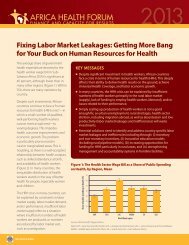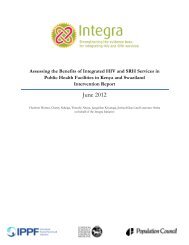ujh78
ujh78
ujh78
You also want an ePaper? Increase the reach of your titles
YUMPU automatically turns print PDFs into web optimized ePapers that Google loves.
children living with a female household head than for children living in a male headed household (61%<br />
compared with 51%).<br />
In three countries the percentage of children living in houses with mud floors was much higher<br />
for children living with a household head at least 50 years old than for children living with a younger<br />
household head—Namibia (difference of 28 percentage points), Lesotho (17 percentage points), and<br />
Zambia (11 percentage points) (see Figure 5.4 and Table 5.1).<br />
Variations during the last 13 years<br />
Ghana (3 percentage points), Nigeria (4 percentage points), and Zambia (3 percentage points)<br />
experienced an increase on the percentage of children living in houses with mud flooring (see Figures 5.5<br />
and 5.6). In the other countries the percentage of children living in houses with mud floors decreased. As<br />
for changes by age group, in Zambia the percentage among children five to nine years old increased by 7<br />
percentage points (2001-02: 59% and 2007: 66%). In contrast, among those ages 15-17, the percentage<br />
decreased by 7 percentage points (2001-02: 57% and 2007: 50%) (see Table 5.2). Overall, Mozambique<br />
experienced the greatest decrease, from 72% in 2003 to 56% in 2011, a reduction of 15 percentage points.<br />
5.2 Living in Houses without Electricity<br />
Today, 1.3 billion people in the world do not have access to electricity (United Nations<br />
Foundation, 2013). According to the International Energy Agency, more than four-fifths of these people<br />
live in rural areas, and more than 95% live in sub-Saharan Africa or developing areas in Asia (United<br />
Nations Foundation, 2013). The use of clean fuels such as gas and electricity for cooking—instead of<br />
biomass fuels, charcoal, and kerosene—is crucial to reduce important health risks affecting developing<br />
countries, such as respiratory diseases (acute respiratory infections, chronic obstructive pulmonary<br />
disease, tuberculosis, and asthma), low birth weight, cataracts, and blindness (Bruce et al., 2000;<br />
Kilabuko and Nakai, 2007). A study using DHS data from six francophone countries in Central and West<br />
sub-Saharan Africa suggested that the most important contributors to the rural-urban gap in infant<br />
mortality rates are environmental factors such as lack of electricity, an unsafe source of drinking water,<br />
and the poor quality of housing materials (van de Poel et al., 2009). The impact of these disadvantageous<br />
environmental conditions on infant mortality rates in rural areas reflects a lack of community-level<br />
infrastructure and the inability of some households to exploit the infrastructure when available.<br />
The United Nations (2013) has identified five areas in which promoting electricity in developing<br />
countries is crucial:<br />
• Education: Electricity provides heating, cooling, and lighting so students can learn. Schools<br />
can stay open later and provide a space for students to study and for teachers to prepare.<br />
• Health care: Health care workers and facilities need electricity to refrigerate vaccines,<br />
sterilize instruments, and power equipment and to provide light for procedures that cannot<br />
wait until daytime (e.g., when a pregnant woman goes into labor at night).<br />
• Business: Businesses need electricity for lighting, to run machinery, and to power<br />
communications technologies.<br />
• Agriculture: Electricity enables farmers to increase efficiency in the production, processing,<br />
and storage of crops.<br />
• Communities: Electricity helps strengthen communities. For example, lighting makes<br />
communities safer at night, and electricity can pump and filter water to provide clean<br />
drinking water.<br />
88








